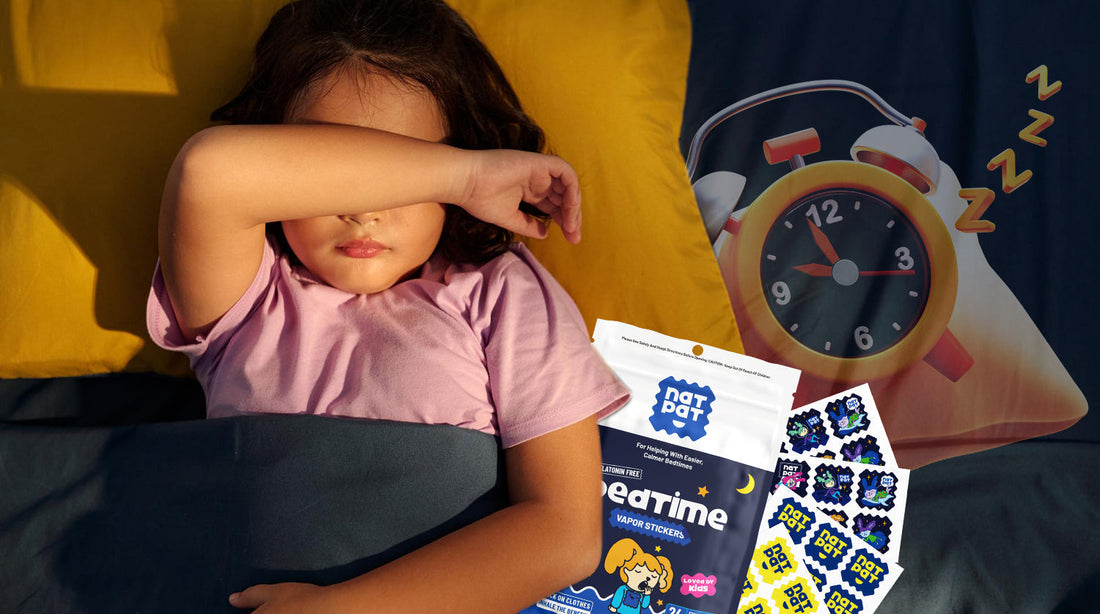How Daylight Saving Time Disrupts Kids’ Sleep Around the World - And the Science of NATPAT’s Natural Bedtime Stickers
- person Michael Jankie
- calendar_today
- comment 0 comments

Twice a year, millions of families brace for the same bedtime challenge: Daylight Saving Time (DST). The clock shifts forward or backward by one hour, but the real cost is often measured in bedtime battles, groggy mornings, and overtired children.
This disruption isn’t just anecdotal. Scientific research across the United States, Europe, the UK, Australia, and New Zealand confirms that adjusting the clock has measurable impacts on children’s sleep quality, mood, and daily functioning. Families in regions without DST, such as Arizona, Hawaii, Queensland, Western Australia, and the Northern Territory, provide an interesting “control group” — they skip the biannual chaos entirely.
As a global wellness brand, NATPAT tracks these shifts closely. Our Bedtime Vapour Stickers, available in major global retailers, are designed to give parents a natural, science-backed tool to help children navigate these transitions more smoothly.
The Science of Sleep and Daylight Saving
-
Circadian Rhythm and the Body Clock
Humans operate on a roughly 24-hour circadian rhythm, regulated by light exposure and hormonal cycles. For children, this rhythm is even more sensitive because their bodies require 9–11 hours of sleep nightly for optimal cognitive and emotional development.
When clocks shift forward, it creates a misalignment between external time (the clock) and biological time (the circadian rhythm). Children are suddenly expected to fall asleep an hour earlier than their bodies are ready for. Conversely, when clocks fall back, kids often wake too early, disrupting morning rest.
- A large-scale study from the Project Baseline Health Study found that people sleep 20–30 minutes less per night in the week following DST, reporting higher sleepiness and reduced morning alertness†.
- Research on adolescents showed reduced vigilance and academic performance for up to a week after the clock change†.
-
Neurological Consequences
The brain’s suprachiasmatic nucleus (SCN), located in the hypothalamus, acts as the central clock. It synchronizes to light exposure — primarily morning sunlight. DST shifts delay this synchronization, especially problematic in children, who are more sensitive to light cues.
DST transitions have been linked not only to sleep loss but also to:
- Increased mood instability and tantrums in younger children.
- Measurable decreases in school performance in older children.
- Immune suppression when chronic sleep loss compounds.
-
Global Variability
DST is not applied uniformly worldwide:
- US/Canada: Observed in 48 states, not in Arizona and Hawaii.
- Europe/UK: Almost universal, though the EU has debated abolishing it.
- Australia/NZ: NSW, VIC, SA, TAS, ACT, and NZ follow it; QLD, NT, WA do not.
This unevenness provides natural data: in NATPAT’s sales, we see significant increases in DST-observing regions (20–30%), while non-DST regions remain stable — a pattern that reinforces how disruptive these shifts are to family routines.
The Science of NATPAT’s Bedtime Stickers
NATPAT’s Bedtime Vapour Stickers are rooted in both biological science and behavioral psychology. They combine essential oils with habit-forming cues to support healthy sleep.
-
Essential Oils and Olfactory Pathways
Unlike other senses, smell has a direct neurological pathway to the limbic system, the part of the brain that regulates emotion and sleep.
- Lavender: Shown in multiple clinical trials to improve slow-wave (deep) sleep and reduce anxiety†.
- Mandarin: Provides gentle sedative effects, safe for children, reducing nighttime restlessness.
- Sweet Marjoram: Traditionally used for relaxation and muscle calming.
These oils stimulate the parasympathetic nervous system (rest-and-digest), lowering heart rate and respiration, preparing the body for sleep.
-
AromaWeave® Technology
Our patented AromaWeave® system allows oils to diffuse steadily for up to 8 hours, unlike sprays or diffusers that spike and fade. This ensures consistent sleep support throughout the night — particularly valuable during transitional weeks like DST when circadian rhythms are unsettled.
-
Behavioral Cueing
Children respond strongly to predictable sensory cues. NATPAT stickers act as both a psychological and sensory bedtime anchor:
- A tangible “badge” kids can wear or place on pajamas.
- A calming scent they begin to associate with sleep.
- A ritual that makes bedtime cooperation easier for parents.
Over time, this cue-response mechanism helps form stronger bedtime habits, which makes transitions like DST or holidays less disruptive.
NATPAT’s Global Data on DST and Bedtime
Our data (extrapolated from multiple markets) consistently shows:
- +28% sales increase in DST-observing states/countries (e.g. California, New York, NSW, VIC) in the week post-clock change.
- Flat growth in non-DST regions (e.g. Arizona, Hawaii, Queensland).
- 35% of online orders placed after 8pm in DST states — evidence of “panic buying” when bedtime struggles are happening in real time.
- Repeat customers up 20–25% YoY during DST months — families come back to NATPAT as a trusted solution.
Tips for Parents Around the Globe
Regardless of hemisphere, these science-backed strategies help smooth the DST transition:
- Gradual Shift: Adjust bedtime by 15 minutes per night for 3–4 days before the clock change.
- Anchor with Cues: Use NATPAT Bedtime Stickers consistently as part of the bedtime ritual.
- Light Exposure: Maximize morning sunlight to reset circadian rhythms; dim evening lights.
- Limit Screens: Avoid blue-light exposure from tablets/phones in the hour before bed.
- Routine Consistency: Bath, story, sticker, lights out — kids thrive on predictability.
Where to Find NATPAT Globally
Parents worldwide can access NATPAT products easily via trusted retail partners:
- United States & Canada: Amazon, Target, Walmart
- United Kingdom & Europe: Amazon UK,
- Australia: Woolworths, Chemist Warehouse
Full list: NATPAT Stockists Page
Conclusion
Daylight Saving Time is a small shift on the clock, but for children it represents a significant disruption to biology and behavior. By combining scientific insights on circadian rhythms and essential oils with practical bedtime routines, NATPAT Bedtime Stickers offer families worldwide a safe, natural, and effective way to navigate these challenging transitions.
From Sydney to New York, London to Auckland, the bedtime battle looks the same — but now, parents have a natural tool to make bedtime calmer, even when the clocks don’t cooperate.
